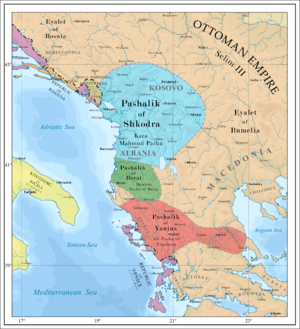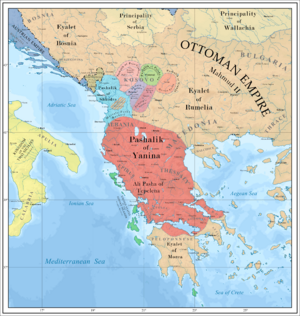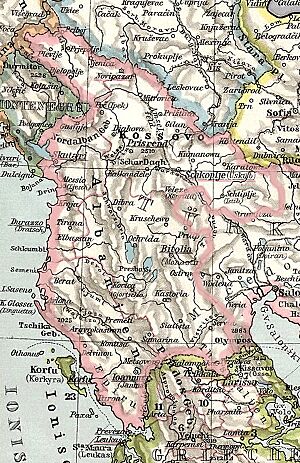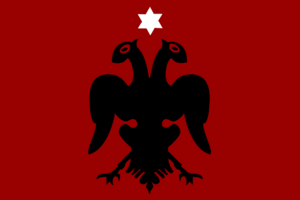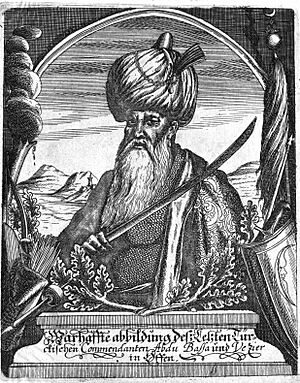Ottoman Albania facts for kids
Quick facts for kids
Ottoman Albania
Historia e Shqipërisë në Perandorinë Osmane (Albanian)
|
|
|---|---|
| 1479–1912 | |
|
1) Location of Ottoman Albania, Map commissioned by Pope Clement XI after funding an expedition in Albania to locate his family's origins. 2) Map of the Albanian Vilayet.
|
|
| Common languages | Albanian |
| Religion | Sunni Islam (official) Christianity (Eastern Orthodox, Roman Catholicism) |
| Demonym(s) | Arnaut (ارناود) |
| Government | |
| Beylerbey, Pasha, Agha, Dey | |
| History | |
|
• Siege of Shkodra
|
1479 |
|
• Independence
|
1912 |
| Today part of | Albania |
Ottoman Albania describes the time when the Ottoman Empire ruled over parts of Albania. This period lasted from the late 1400s until 1912. In 1912, Albania declared its independence.
The Ottomans first came to Albania in 1385. They were invited by an Albanian noble named Karl Thopia. He wanted help against his rival, Balša II. The Ottomans won the Battle of Savra. By the 1420s, they had military bases in southern Albania. By 1431, they had formal control in central Albania.
Even though the Ottomans claimed all Albanian lands, many areas were still ruled by Albanian nobles. These nobles were free from Ottoman control. The Ottomans called the region Arnavudluk. This name included modern-day Albania, Kosovo, western North Macedonia, and parts of Serbia and Montenegro.
From 1443 to 1481, much of Albania was free. This was thanks to an uprising led by Skanderbeg. He worked with other Albanian nobles like Gjergj Arianiti. They won over 30 battles against the Ottoman Empire. The Albanian resistance lasted for 48 years. The last major towns to fall were Shkodër in 1480 and Durrës in 1501. Some northern mountain areas, like Mirdita, were never fully conquered. They kept their freedom with their own rulers.
Over time, many Albanians started converting to Islam. This happened especially in the 1500s and 1600s. By converting, Albanians gained important roles in the Ottoman Empire. They became very influential in the 17th, 18th, and 19th centuries.
In the 1750s, local Albanian rulers gained more independence. This led to the era of the "Independent Albanian Pashas." The Pashalik of Shkodra was set up in 1754. Later, the Pashalik of Berat was formed. The most famous was the Pashalik of Yanina under Ali Pashe Tepelena in 1787. These independent Albanian regions ended by 1831.
An Albanian commander, Mehmet Ali of Egypt, took control of Egypt in 1805. He started a dynasty that lasted until 1954. His forces also took over parts of Sudan and Saudi Arabia. They even defeated the Ottomans in 1833. European powers had to step in to stop him from taking Constantinople.
Albania remained part of the Ottoman Empire until 1912. It declared independence during the Balkan Wars.
A Look at History
Ottoman Expansion and Early Control
The Ottoman Turks began expanding into the Balkans in the mid-1300s. They defeated a large Balkan army in the Battle of Kosovo in 1389. This army included Serbs, Albanians, and Bosnians. Ottoman pressure eased for a while after 1402. This was because the Mongol leader Timur attacked Anatolia.
The Albanian lands were divided into many small areas. These areas were ruled by different local lords. This made it easy for the Ottoman armies to conquer them. In 1385, Karl Thopia asked the Sultan for help. He needed help against his rivals, the Balsha noble family. An Ottoman force quickly entered Albania. They defeated Balsha II in the Battle of Savra.
After 1420, some Albanian areas became part of the Ottoman Empire. Gjirokastra became the main town of the Sanjak of Albania in 1420. Later, Kruja became its center. The Ottomans allowed Albanian clan chiefs to keep their power. But they had to pay taxes and sometimes send their sons to the Ottoman court. Many Albanian groups, however, did not accept Ottoman rule.
Albanian Resistance and Skanderbeg
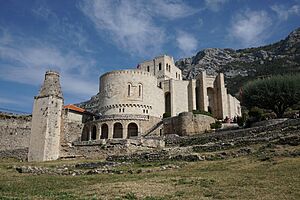
The Albanian resistance against the Ottomans became famous in Europe. Gjon Kastrioti of Krujë was an Albanian noble. He submitted to Ottoman rule in 1425. He had to send his four sons to the Ottoman capital. His youngest son, George Kastrioti, caught the Sultan's eye. He was renamed Iskander and became a top Ottoman general.
In 1443, Ottoman forces lost a battle near Niš. Skanderbeg, who was leading them, intentionally caused this defeat. He then rushed to Krujë. He tricked a Turkish pasha into giving up the Albanian fortress. Skanderbeg then became a Roman Catholic. He declared a holy war against the Ottoman Empire.
On March 1, 1444, Albanian leaders met in Lezhë. They declared Skanderbeg the leader of the Albanian resistance. All of Albania supported him against the Ottomans. But local leaders still controlled their own areas. Under a red flag with Skanderbeg's eagle, about 10,000-15,000 Albanian fighters held off Ottoman attacks for 24 years. They continued for another 11 years after his death.
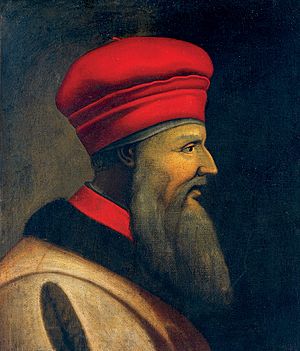
The Albanians successfully defended Krujë three times. In 1450, they defeated Sultan Murad II. They also pushed back attacks by Sultan Mehmed II in 1466 and 1467. Skanderbeg even helped the King of Naples in Italy.
Sometimes, Skanderbeg's rule was not stable. Some local Albanian rulers even worked with the Ottomans against him. The resistance continued for 36 years with support from Naples and the Vatican.
Krujë finally fell to the Ottomans in 1478. This was ten years after Skanderbeg's death. Shkodër fell in 1479, and Durrës in 1501. These conquests caused many Albanian nobles to leave. They went to Venice, Italy, Sicily, and Egypt. Many of these refugees were Orthodox Christians. Albanians in Italy later helped inspire the Albanian national movement.
Skanderbeg's long fight for freedom was very important to Albanians. It made them feel more united and aware of their national identity. His family's flag, a black two-headed eagle on red, became the Flag of Albania. It was used by the Albanian national movement centuries later.
The 16th and 17th Centuries: Islam's Influence
Many Albanians slowly started to convert to Islam. This was partly due to the teachings of Bektashism. Converting to Islam offered many benefits in Ottoman trade, government, and the army. Many Albanians joined the Janissary corps. They became very successful military and political leaders. This encouraged other Albanians to convert.
Albanians became very important in the Ottoman Empire. They held powerful positions, even though they were a small part of the empire's population. They played a key role from the 15th century onwards. Their influence grew even more in the 17th, 18th, and 19th centuries.
For example, 48 Grand Viziers were of Albanian origin. A Grand Vizier was like the Sultan's chief minister. Some famous Albanians during Ottoman rule included George Kastrioti Skanderbeg and Mimar Sinan, a famous architect.
Albanians also played a big part in Ottoman wars. These included conflicts against Venice, Hungary, and the Habsburgs. The Ottoman Empire relied heavily on Albanian soldiers from the early 1600s to the mid-1800s.
The 18th and 19th Centuries: Albanian Rulers

The Ottoman Empire's central power became weaker. This led to chaos in Albanian-populated lands. In the 1700s, two main Albanian power centers appeared. One was Shkodër, ruled by the Bushati family. The other was Ioannina, led by Ali Pasha of Tepelenë. These rulers sometimes worked with the Ottoman government. Other times, they acted independently.
The Bushati family first controlled the Shkodër region. They made alliances with mountain tribes. Their power grew to include parts of modern-day Montenegro, Kosovo, and Macedonia. Kara Mahmud Bushati tried to create his own independent state. He played Austria and Russia against the Ottomans. In 1785, his forces attacked Montenegro. Austria offered to recognize him as ruler of all Albania. But Kara Mahmud instead sent the heads of an Austrian group to the Sultan. The Ottomans then made him governor of Shkodër. He was killed in 1796 while fighting in Montenegro.
During the late 1700s and early 1800s, Albanian rulers became very powerful. Their lands stretched from Bosnia to southern Greece. This was a peak of Albanian power.
South of the Shkumbini River, most people were farmers called Tosks. They lived in villages with elected leaders. Some mountain Tosks stayed independent and avoided taxes. But the lowland Tosks were easier for the Ottomans to control. The Ottoman system of military land grants, called timars, became common. These landholdings became hereditary for powerful families. These families, called beys, became almost independent rulers. They had their own armies and often fought each other. The Ottoman government tried to keep them divided.
Relations between the Ottomans and Albanians worsened in 1826. Sultan Mahmud II dissolved the Janissary corps. This caused unrest in the Balkans.
After defeating the Bushatis and Ali Pasha, the Ottomans tried to reform their empire. These reforms were called the tanzimat. They aimed to strengthen the empire by controlling powerful local rulers. In 1835, the Albanian lands were divided into new districts, called vilayets. Officials from Constantinople were sent to govern them. This led to revolts in 1843–1844, but the Ottoman army put them down.
After 1865, the Albanian lands were redivided. The reforms angered the northern Albanian chiefs. Their special rights were reduced. The Ottomans eventually stopped trying to control them. But they crushed rebellions in the lowlands. Many Tosks moved to other countries. They went to Romania, Egypt, Bulgaria, and the United States.
The 20th Century: Towards Independence
In 1906, new groups emerged in the Ottoman Empire. One was the Young Turks. They wanted to bring back constitutional government. In July 1908, a Young Turk rebellion began in Macedonia. Albanians in Kosovo and Vardar Macedonia also rose up. Sultan Abdül Hamid II agreed to restore constitutional rule. Many Albanians joined the Young Turks. They hoped to gain more freedom within the empire.
The Young Turks lifted the ban on Albanian language schools. They also allowed writing in Albanian. In 1908, Albanian thinkers chose the Latin alphabet as the standard script. However, the Young Turks wanted to keep the empire together. They were not interested in giving groups like Albanians more freedom. After the Sultan was removed in 1909, the new government imposed taxes. They outlawed rebel groups and nationalist societies. They also tried to control the northern Albanian mountain people. The Young Turks even banned carrying rifles. They denied that Albanians were a separate nationality. They also tried to use Muslim leaders to force the Arabic alphabet on Albanians. They banned the Flag of Albania.
Albanians refused to be "Ottomanized" by force. New Albanian uprisings began in Kosovo in 1910. Ottoman forces crushed these rebellions. They banned Albanian groups and closed schools. Montenegro, which wanted Albanian lands, supported a 1911 uprising. This revolt grew widespread. The Ottoman government could not control the Albanians by force. So, they made some promises. They allowed Albanian schools and the Latin script. But they refused to unite the four Albanian-inhabited regions into one.
How Albania Was Governed
The Ottomans divided the Albanian lands into several districts called vilayets. The Ottomans did not force people to convert to Islam. Conversion was first done by Albanian nobles in the late 1300s. Then, it was slowly accepted by the general population.
By 1479, almost all of Albania was under Ottoman rule. Many important Ottoman leaders, called viziers and pashas, came from Albania. They were appointed to their roles even before most Albanians became Muslim.
Administrative Divisions and Society
The Ottoman Sultan saw himself as God's representative on Earth. His state was religious, not national. Its goal was to protect and spread Islam. Non-Muslims paid extra taxes. They had a lower status but could keep their religion. They also had some local self-rule. By converting to Islam, people could rise in society.
In the early empire, high Ottoman officials were often Christian children. They were chosen for their potential, converted to Islam, and trained to serve. Some were prisoners of war. Others were given as gifts. Some were taken through the devshirme system. This was a tax on Christian children in the Balkans. Many of the best fighters in the Sultan's elite guard, the janissaries, were young boys from Christian Albanian families. High-ranking Ottoman officials often had Albanian bodyguards.
Taxes and Mountain Independence
According to historian Zija Shkodra, Albania was as developed as other Balkan areas. In the mountains north of the Shkumbini River, Geg herders kept their self-governing society. This society was based on clans. A group of clans was called a bajrak.
It was very hard for the Ottomans to collect taxes from the northern tribes. This was because of the rough land and the fierce Albanian highlanders. Some mountain tribes kept their independence for centuries. They fought small wars with the Ottomans. The Ottomans never thought it was worth fully conquering them.
Until recently, Geg clan chiefs, or bajraktars, held great power. They arranged marriages, settled arguments, and gave out punishments. The northern Albanian mountain tribes followed only the Code of Lekë Dukagjini. This was a collection of tribal laws written down in the 14th century. The code covered many topics, including blood feuds. Even today, many Albanian highlanders see this code as the highest law.
Culture and Religion
Religion and Identity
Four centuries of Ottoman rule shaped Albanian people. They were divided by religion, region, and tribe. In the 1500s and early 1600s, many Albanians converted to Islam. Within a century, Muslim Albanians became the largest religious group. They lost their earlier Christian identities.
Albanians were divided into two main groups: the Gegs and Tosks. These groups also spoke different dialects. In the rugged northern mountains, Geg shepherds lived in tribal societies. They were often fully independent of Ottoman rule. In the south, Muslim and Orthodox Tosks worked the land. They worked for Muslim beys, who often rebelled against the Sultan.
Many Albanian converts to Islam moved away from the Ottoman Empire. Some gained powerful positions in the Ottoman government. This put Catholic communities at a disadvantage. About 48 Albanians became Grand Viziers. In the late 1600s, the Albanian Köprülü family provided six Grand Viziers. They fought corruption and won many military victories. They helped expand the Ottoman Empire to Vienna and Ukraine.
In the 1700s, a mystic Islamic group called the Bektashi dervishes spread into Albanian lands. Bektashism became the official faith of the Janissaries in the late 1500s. This group had beliefs different from standard Islam. They believed humans reflected the Divine. Women, veiled, took part in ceremonies. They also used wine, even though alcohol is usually banned in Islam. Bektashi leaders played key roles in the Albanian nationalist movement of the late 1800s.
In the 1800s, Ottoman Sultans tried to save their empire. They introduced reforms to control local officials. They also tried to stop nationalism among their many peoples. But the power of nationalism was too strong.
Today, Albanians often do not have strong religious ties. This is because of about 50 years of Communism. During this time, practicing religion was banned.
See also
- Albania in the Middle Ages
- Albanian Renaissance




